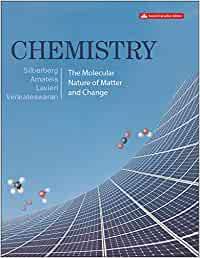Test Bank For Organic Chemistry 4th Edition By Janice Smith
ISBN-10: 1259336301, ISBN-13: 978-1259336300
Chapter 1: Structure and Bonding
| 1. | What is the ground-state electronic configuration of a carbon atom? |
| A) 1s2, 2s2, 2p5 B) 1s2, 2s2, 2p2 C) 1s2, 2s2, 2p6 D) 1s2, 2s2, 2p4 |
| 2. | What is the ground-state electronic configuration of a fluorine atom? |
| A) 1s2, 2s2, 2p2 B) 1s2, 2s2, 2p3 C) 1s2, 2s2, 2p4 D) 1s2, 2s2, 2p5 |
| 3. | What is the ground-state electronic configuration of a magnesium cation (Mg2+)? | |||
| A) | 1s2, 2s2, 2p6 | C) | 1s2, 2s2, 2p6, 3s2 | |
| B) | 1s2, 2s2, 2p6, 3s1 | D) | 1s2, 2s2, 2p6, 3s2, 3p2 | |
| 4. | What is the ground-state electronic configuration of a chlorine anion (Cl—)? | |||
| A) | 1s2, 2s2, 2p6 | C) | 1s2, 2s2, 2p6, 3s2, 3p5 | |
| B) | 1s2, 2s2, 2p6, 3s2, 3p6 | D) | 1s2, 2s2, 2p6, 3s2, 3p4 | |
| 5. | Which of the following statements about valence electrons is true? | |
| A) | They are the most tightly held electrons. | |
| B) | They do not participate in chemical reactions. | |
| C) | They are the outermost electrons. | |
| D) | They reveal the period number of a second-row element. | |
| 6. | Which of the following statements about bonding is true? | |
| A) | Covalent bonds result from the transfer of electrons from one element to another. | |
| B) | Ionic bonds result from the transfer of electrons from a metal to a non-metal. | |
| C) | Ionic bonds result from the sharing of electrons between two non-metals. | |
| D) | Covalent bonds result from the sharing of electrons between two metals. | |
| 7. | Which of the following would you expect to have ionic bonds? |
| A) CO B) FBr C) NF3 D) NaCl |
| 8. | Which of the following molecules has nonpolar covalent bonds? |
| A) HCl B) N2 C) CHCl3 D) NO |
| 9. | Which of the following molecules contain both covalent and ionic bonds?
|
| A) I, II B) I, IV C) II, III D) II, IV |
| 10. | Arrange the following bonds in decreasing order of ionic character, putting the most ionic first.
|
|||
| A) | I > II > III > IV | C) | IV > III > II > I | |
| B) | IV > II > I > III | D) | IV > II > III > I | |
| 11. | Which of the following statements correctly describes the typical number of bonds for carbon, nitrogen, and oxygen in most neutral organic molecules? | |
| A) | Carbon forms 4 covalent bonds, nitrogen forms 2 covalent bonds and oxygen forms 3 covalent bonds. | |
| B) | Carbon forms 4 covalent bonds, nitrogen forms 3 covalent bonds and oxygen forms 2 covalent bonds. | |
| C) | Carbon forms 4 covalent bonds, nitrogen forms 5 covalent bonds and oxygen forms 2 covalent bonds. | |
| D) | Carbon forms 4 covalent bonds, nitrogen forms 5 covalent bonds and oxygen forms 4 covalent bonds. | |
| 12. | Which is not an acceptable Lewis structure for the anion CH2NCO—?
|
| A) I B) II C) III D) IV |
| 13. | Which of the following Lewis structures is correct?
|
| A) I B) II C) III D) IV |
| 14. | Which of the following Lewis structures is correct?
|
| A) I, II B) I, III C) II, III D) III, IV |
| 15. | Which is the correct Lewis structure for acetic acid (CH3CO2H)?
|
| A) I B) II C) III D) IV |
| 16. | In which of the following ions does carbon have a formal charge?
|
| A) I B) II C) III D) None of the above |
| 17. | In which of the following ions does carbon have a formal charge?
|
| A) I B) II C) III D) None of the above |
| 18. | What is the formal charge of carbon in carbon monoxide (CO) when drawn with a triple bond? |
| A) 0 B) -2 C) -1 D) +1 |
| 19. | Which of the following statements about constitutional isomers is true? | |
| A) | Constitutional isomers are different molecules having different molecular formula. | |
| B) | Constitutional isomers are different molecules having same molecular formula. | |
| C) | Constitutional isomers are same molecules having different molecular formula. | |
| D) | Constitutional isomers are same molecules having the same molecular formula. | |
| 20. | How many constitutional isomers are there for a molecule having the molecular formula C2H6O? |
| A) 1 B) 2 C) 3 D) 4 |









Reviews
There are no reviews yet.